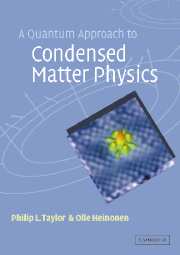Book contents
- Frontmatter
- Contents
- Preface
- Chapter 1 Semiclassical introduction
- Chapter 2 Second quantization and the electron gas
- Chapter 3 Boson systems
- Chapter 4 One-electron theory
- Chapter 5 Density functional theory
- Chapter 6 Electron–phonon interactions
- Chapter 7 Superconductivity
- Chapter 8 Semiclassical theory of conductivity in metals
- Chapter 9 Mesoscopic physics
- Chapter 10 The quantum Hall effect
- Chapter 11 The Kondo effect and heavy fermions
- Bibliography
- Index
Chapter 9 - Mesoscopic physics
Published online by Cambridge University Press: 05 June 2012
- Frontmatter
- Contents
- Preface
- Chapter 1 Semiclassical introduction
- Chapter 2 Second quantization and the electron gas
- Chapter 3 Boson systems
- Chapter 4 One-electron theory
- Chapter 5 Density functional theory
- Chapter 6 Electron–phonon interactions
- Chapter 7 Superconductivity
- Chapter 8 Semiclassical theory of conductivity in metals
- Chapter 9 Mesoscopic physics
- Chapter 10 The quantum Hall effect
- Chapter 11 The Kondo effect and heavy fermions
- Bibliography
- Index
Summary
Conductance quantization in quantum point contacts
In Chapter 8 we discussed the Boltzmann equation and the approach to describing transport properties, such as electrical conductivity, that it provides. In general, this approach works very well for most common metals and semiconductors, but there are cases where it fundamentally fails. This happens, for example, when the wave nature of the electron manifests itself and has to be included in the description of the scattering. In this case, interference may occur, which can affect the electrical conduction. We recall that the Boltzmann equation describes the electron states only through a dispersion relation of the Bloch states of an underlying perfect crystal lattice, a probability function, and a scattering function that gives the probability per unit time of scattering from one state to another. All these quantities are real, and do not contain any phase information about the electron states. Consequently, no wave–like phenomena can be described. The question then arises as to when the phase information is important. This really boils down to a question of length scales. We have earlier talked about the mean free path of an electron, which is roughly the distance it travels between scattering events. A simple example is given by scattering off static impurities that have no internal degrees of freedom. In this case the electron scattering is elastic, since an electron must have the same energy before and after a scattering event. Furthermore, in the presence of impurity scattering the phase of an electron wavefunction after a scattering event is uniquely determined by the phase before the scattering event.
- Type
- Chapter
- Information
- A Quantum Approach to Condensed Matter Physics , pp. 315 - 341Publisher: Cambridge University PressPrint publication year: 2002



